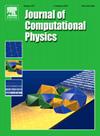A physical-constraints-preserving arbitrary Lagrangian-Eulerian discontinuous Galerkin scheme on adaptive quadrilateral meshes for compressible multi-material flows
IF 3.8
2区 物理与天体物理
Q2 COMPUTER SCIENCE, INTERDISCIPLINARY APPLICATIONS
引用次数: 0
Abstract
In this paper, a high-order physical-constraints-preserving arbitrary Lagrangian-Eulerian (ALE) discontinuous Galerkin (DG) scheme on adaptive quadrilateral meshes is proposed for compressible multi-material flows. Our scheme couples a conservative equation related to the volume fraction model with Euler equations for describing dynamics of fluid mixture. The mesh velocity in the ALE framework is obtained by using an adaptive mesh method which can automatically concentrate the mesh nodes near the regions involving large gradient values, and it can help the scheme greatly reduce the numerical dissipation near material interfaces. Using this adaptive mesh, the resolution of solution near some special regions such as material interfaces can be improved effectively by our scheme. With the appropriate time step condition and using a physical-constraints-preserving limiter, our scheme can ensure the positivity of density and pressure and the boundness of volume fraction, which further ensures the computational robustness and degree of confidence of simulations under large density or pressure ratios and so on. In general, our scheme can be applied into the simulations of compressible multi-material flows efficiently with the essentially non-oscillatory property and physical-constraints-preserving (bound-preserving and positivity-preserving) property, and its steps are more concise compared to some other methods such as the indirect ALE methods. Some examples are tested to demonstrate the accuracy, essentially non-oscillatory property and physical-constraints-preserving property of our scheme.
求助全文
约1分钟内获得全文
求助全文
来源期刊

Journal of Computational Physics
物理-计算机:跨学科应用
CiteScore
7.60
自引率
14.60%
发文量
763
审稿时长
5.8 months
期刊介绍:
Journal of Computational Physics thoroughly treats the computational aspects of physical problems, presenting techniques for the numerical solution of mathematical equations arising in all areas of physics. The journal seeks to emphasize methods that cross disciplinary boundaries.
The Journal of Computational Physics also publishes short notes of 4 pages or less (including figures, tables, and references but excluding title pages). Letters to the Editor commenting on articles already published in this Journal will also be considered. Neither notes nor letters should have an abstract.
 求助内容:
求助内容: 应助结果提醒方式:
应助结果提醒方式:


